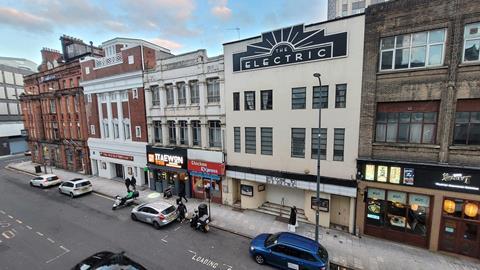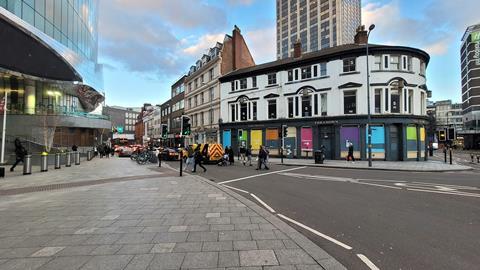Birmingham is the canary in the coal mine, showing us how financially stricken local authorities are increasingly sacrificing cultural assets in pursuit of investment, writes Simeon Shtebunaev

The second city of the UK, the birthplace of the civic gospel philosophy, which once led the world in enlightened municipal governance, seems to have all but forgotten what makes a place thrive, and is now carelessly risking the future of its cultural assets. Birmingham is the canary in the coal mine, showing us where many local authorities might be heading. Lacking strong leadership, pressured by funding formulas and housing targets, cities like Birmingham are demonstrating an increasing willingness to disregard their culture and heritage in a desperate bid for short term survival that prioritises investment at almost any cost.
Recent news from the city paints a picture of cultural infrastructure under threat. There are fears that Station Street, home to a string of culturally significant buildings, could be lost to new residential development.
The closure of the Electric Cinema, the oldest continuously operating cinema in the UK, has been the final straw, galvanising Brummies to speak out. A petition calling for the cinema to be saved has already attracted over 19,000 signatures.
We know that local authorities are facing crippling cuts to their central government funding - a challenge compounded in Birmingham’s case by issues relating to an equal pay dispute and spiralling costs for a new finance and HR system. But destroying the city’s cultural capital will not solve the city’s crushing problems - in fact, all the evidence shows that cuts to cultural organisations and failure to protect arts venues is likely to contribute to further decline.
The city’s recently approved budget will cut cultural funding entirely for internationally important organisations such as the Ikon Gallery and the City of Birmingham Symphony Orchestra. It will trigger the sell-off of 11 community centres, the closure of 25 libraries, the loss of youth centres and redundancies amongst the council’s staff, including within the already stretched planning department.
The huge cuts now being made to council services and the arts are a bitter pill to swallow
All of this comes on the back of the Commonwealth Games in 2022, which fostered so much elation and local pride, followed by talk of a golden decade in the city. Having delivered the games with an unprecedented £70m underspend, the huge cuts now being made to council services and the arts are a bitter pill to swallow.
On the other hand, in the last few years, Birmingham has seen a boom in residential developments - scheme after scheme, each delivering hundreds of units to address the more than 7,000 units per annum target that the city seeks to deliver. Many of the developments are high-rise build to rent (BTR) schemes, that will leave a mark on the city’s skyline for years to come. They are also pushing out the creative and cultural sectors operating in the city by inflating land prices and rents.

Open any brochure and with very few exceptions you will notice something - the amenities in these schemes, if provided, are often for residents only. The designs rarely include public use at ground floor or flexible commercial spaces to rent. Each development is intended to serve the perceived cultural tastes of their occupiers as dictated by marketing experts - with gyms, saunas, cinema rooms, arcade rooms, and private landscaped podium gardens for barbecues.
Each one of these developments assumes that their prospective residents will somehow benefit from a vibrant cultural scene delivered somewhere else by someone else, in part supported by their development contributions. Work hard and play hard they say.
But how much of a cultural scene will survive this type of development? It is no wonder that the Quality of Life Foundation launched research into the social impact of the built-to-rent sector this month.
The story of Birmingham Open Media’s (BOM) journey to bring the Old Crown Pub back into active cultural use is an example of how quickly the lack of local authority support can scupper a project. The building, a key venue in the development of heavy metal in Birmingham, was given Grade II listing last week, but currently sits unused and boarded up. Even BOM’s project, which had the backing of local communities, the Community Ownership Fund, Arts Council England and the John Feeney Trust, could not stack up the viability without a loan commitment from the council.

In the context of a bankrupted local authority the argument that current levels of developer contributions are able to sufficiently support the development of public goods such as cultural amenities is quickly becoming outdated. We can’t continue to pretend that the development market is serving anyone else but a specific segment of the housing sector. We need stronger public sector leadership.
To underestimate the value and output of the cultural and creative industries to the economy and prosperity of the region is dangerous. The West Midlands Cultural Sector Research conducted in 2021 demonstrated the sector’s output to be £1.1bn, directly responsible for the employment of 16,320 people. 2,138 spaces were identified as hosting and supporting cultural and creative activities - spaces whose business model and long-term future are now increasingly at risk.
Since 2021 I have chaired the West Midlands Combined Authority’s (WMCA) cultural infrastructure and investment working group. It reports to the WMCA’s cultural leadership board. The board itself was set up by the mayor, Andy Street, to provide a platform for cultural leaders, sorely missed across the constituent authorities. The working group includes cultural and arts practitioners, planners, and policy makers and aims to advocate for and promote the protection of cultural assets as well as their inclusion into new developments.
The views from the cultural sector about the current situation in Birmingham are clear.

Skinder Hundal, chair, cultural leadership board, WMCA
“The West Midlands’ cultural and creative sector is one of our biggest success stories. It is one of the UK’s largest and most developed.
“Birmingham is a major engine for the sector; with the highest density and diversity of cultural and creative employment, and a growing global reputation and role. We work with artists, creatives, innovators and entrepreneurs who connect communities, enrich neighbourhoods and build businesses.
“Their work brings increased health and wellbeing to all our citizens. Culture is a proven superpower regenerator.
“The UK’s creative industries are the largest growth sector in the UK economy; worth £126 billion per year. Culturally rich, creative places attract international industries, refresh local economies, attract new investment, create jobs and drive tourism.”

Jez Collins, director, Birmingham Music Archive and member of the WMCA’s cultural infrastructure and investment working group
“With the recent announcement that Birmingham City Council is to cut 100% of it’s cultural funding which was quickly followed by the news that the Electric Cinema, the UK’s oldest working cinema, has closed its doors, it’s not been a good week for those of us who work and have a vested interest in the cultural infrastructure of our region.
“Station Street, which is where the Electric is located, could become the catalyst for rethinking our approach to the built environment in relation to the city’s cultural heritage, home as it is to the Grade II-listed Old Rep and the Crown Hotel, an historic music venue. Such an historic street should be seen as part of the cultural jewels of Birmingham, a public realm full of creative and cultural activity and an international tourist offer.
“We need to work with landowners and developers, Historic England, local agencies such as the city council and combined authority and with the custodians of these buildings to seek constructive solutions that will retain the integrity of the street and whilst benefiting all parties.”
In 2023 the WMCA working group commissioned and published two key pieces of research by Arup. The two studies - WMCA Repurposing to zero - the role of town planning in directing investment in culture and WMCA - Making the case for culture - were launched in 2023 by Andy Street.
The business case clearly sets out how culture helps to address the needs of developers, for example: the need to offer something different and establish a competitive advantage, improving their reputation amongst communities and local authorities and meeting the objectives and the requirements of an area’s local plan and development strategies. It also demonstrated why the market is broken, as cultural value is often captured in development, rather than for the benefit of its producers.
The town planning paper showed that Local Plans in the West Midlands, where there are local policies and requirements, lack detail or are focused on a small part of the wider cultural sector. Additionally, there is the challenge of understanding the gaps in the cultural offer of a place. There is a clear lack of evidence to link growth in population with its cultural needs.
We need to consider closely what type of cities we want to be developing in the future. Cultural activities and assets are often subsumed into the heritage debate, yet are essential for creating thriving and attractive places.
As built environment professionals we need to put more effort into understanding the cultural sector and support its ecosystems of artists, collectives, cultural practitioners and organisations of all sizes.
>> Also read: Another irreplaceable slice of Birmingham’s architecture and history is at risk
Postscript
Simeon Shtebunaev is a member of the WMCA’s cultural leadership board, and chair of its cultural infrastructure and investment working group. He is a trustee of the RTPI and was RTPI Young Planner of the Year 2022.
















No comments yet